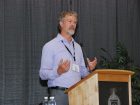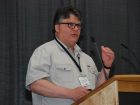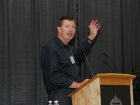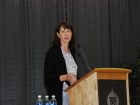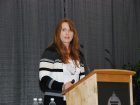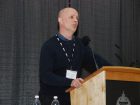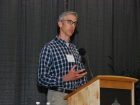
Despite frequent laughs shared by attendees at the annual Wood Products Safety Summit held in Prince George, B.C., yesterday, it was clear safety is serious business for the industry.
Nearly 100 attendees from the wood pellet, wood panels, and sawmill industries, as well as some international guests, gathered to hear lessons learned and best practices for keeping employees safe on the job.
The summit covered many bases, from ways to create a safety culture, to technical combustible dust presentations, and a powerful keynote on the reality of working in an unsafe environment.
Safety culture
The idea of a creating a company safety culture is nothing new, but how to go about effectively doing that has its challenges. But, as summit co-chair Scott Bax, senior vice-president of operations at Pinnacle Renewable Energy, said, it’s not something companies should ignore.
“You are going to get a safety culture whether or not you do something about it. Not doing something creates its own culture. Just acknowledging that is a good first step,” he said.
Pinnacle’s director of health and safety, Steven Mueller, gave the summit’s first presentation on how the pellet producer created a culture of “owning safety.”
“I could give you all kinds of safety records because we have those, but the most important one is our employee engagement,” Mueller said. Since 2016, Pinnacle has received more than 2,400 safety suggestions from staff in the form of hazard reports and recorded conversations about safety.
Key to their success, Mueller said, is their in-house Safety Champions Academy program that launched in 2017 with the goal of building and reinforcing safety culture from the ground up. The program recruits on-the-ground safety leaders for two days of safety training in Prince George. By the end of 2019 nearly 60 safety champions will graduate from the program.
“The return on investment is, I think, invaluable,” Mueller said.
WorkSafeBC’s Gordon Harkness also spoke about building a corporate safety culture, which he says always begins with management. “Safety culture is either driven or dragged by senior management. I’ve seen this hundreds of times. Good culture equals good performance,” he said.
Harkness offered ways to assess corporate safety culture:
- A workplace health and safety climate survey, which measures immediate employee feelings towards safety.
- An evaluations of OHS practices, which involves site tours, program reviews, document and compliance reviews.
- And direct commentary from the workforce, which is written responses or interviews from the employees.
The keys to an effective culture are visible commitment of management, good communications and active employee participation, Harkness said.
Technical updates
Kevin Ericsson with Cariboo Biomass Consulting has been involved in a number of incident investigations on dryer fires in his career. His presentation on best practices for managing combustible gas offered warnings for typical maintenance mishaps or oversights that can lead to a fire.
“NFPA regulations are out there, but they’re not really being applied or enforced. Until they are I think we are going to have these incidents,” Ericsson said.
Dryers are at the greatest risk of explosion, he said, when there is a sudden, unexpected power outage; during scheduled shutdown process; when dryer components fail; when there is faulty fire protection equipment; or when there are distracted operators.
Formal training is needed for dryer operators on the fire safety systems, Ericsson said. Suppliers should provide the documents, but operators should be able to prove they’ve learned the material.
Ericsson played a video from WorkSafeBC that outlines the hazards of combustible wood dust in wood product manufacturing facilities.
Fike Canada’s Western Regional Manager, Kent Desmond, also offered a technical presentation on dust explosion prevention case studies. Fike will be sharing a detailed case study article with Canadian Biomass for Dust Safety Week happening June 24-28.
Safety process
Cherie Whelan with the BC Forest Safety Council presented on challenges and methods to get to “lessons learned” as an industry.
An important step is for companies to assess and determine which workplace incidents qualify as “serious injury fatality potential” or SIFp. “Not all incidents are equal risk. We want to make sure the right measurements are driving the right actions,” Whelan said.
In order to identify SIFp, companies can follow an incident management process that involves four steps:
- notification and reporting
- assessing risk and consequences
- investigation and causal analysis
- corrective and preventative actions, follow-up and lessons learned
“Corrective and preventative actions is a huge part of the process,” Whelan said. “Time and time again this is not done well enough. Momentum sometimes drops off or people may not understand the urgency.”
But potential for injury still exists until all preventative actions are taken, she said. Companies need to find a way to track and report incidents and brief all employees on preventative actions.
Reality of unsafe practices
The safety summit’s guest speaker offered attendees a cautionary story of the consequences of a unsafe work environment, and what can happen when you ignore the “gut feeling” your work is dangerous.
Spencer Beach, a third generation flooring installer in Edmonton, was removing linoleum from an under-construction home with a strong, flammable chemical when the house was engulfed in a flash fire. The chemical fire reached 1,500 degrees, burning 90 per cent of his body in third and fourth degree burns.
Beach was told he had a five per cent chance to live. The months of painful recovery left not only physical scars that left him handicapped, but mental ones too, he said.
Beach said he knew, deep down, working with that chemical was unsafe. “How many of you have been in a situation where you have the gut feeling, and you do nothing at all?” he asked the audience. “But I did what all strong, hardworking people do – I took that feeling and I pushed it deep down to where it can’t be heard. And I did nothing. I chose to die.”
Beach impressed upon the crowd the importance of creating not just an organization safety culture of policies and procedures, but also a compatible workers culture. “You need to show them why it is they want to work and need to work in their organization’s safety culture,” he said.
“My definition of safety is: protect yourself adequately, at home, work, play and while driving, so you have a long, rich, prosperous life, so you get to do all the things you want to,” Beach said.
The Wood Products Safety Summit is presented by the Wood Pellet Association of Canada, along with Canadian Biomass, Canadian Forest Industries and Pulp & Paper Canada magazines. Find this year’s presentations and details on next year’s summit soon at www.woodproductsafetysummit.com.
Print this page


